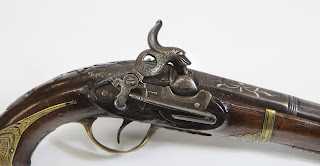 |
Miquelet Pistol, c. 1750
Ripoll, Catalonia, Spain
Wood, engraved brass, iron and steel; 10 3/4 in.
F80.65.1
Bowers Museum Foundation Acquisitions Fund Purchase |
 |
Miquelet Pistol, c. 1750
Ripoll, Catalonia, Spain
Wood, engraved brass, iron and steel; 2 x 10 3/4 x 5 in.
F80.65.2
Bowers Museum Foundation Acquisitions Fund Purchase |
 |
| Detail of F80.65.1 |
These two pistols exemplify the 19th Century standard for firearms, commonly made in Ripoll, Spain which is about two hours northwest of Barcelona. The miquelet is also known as a Spanish lock, and eventually as a Mediterranean lock after its popularity spread. However in most of Spain, this style of flintlock mechanism was called the “llave de rastrillo.” Flintlock pistols are characterized by their use of friction to spark the gunpowder in the barrel and are common of pistols and rifles of the 18th and early 19th Centuries such as muskets .This type of gun first appeared in Spain at the end of the 16th Century. The term ‘miquelet’ comes from the Miquelet mercenaries and militia from the Catalonian region during the 17th and 18th Centuries that used this style of flintlock pistol.
On the first pistol, the butt of the stock has a raised design of what looks to be a face. The lock and barrel both have maker’s marks on them, but the marks are unknown. As was common practice at this time in Europe, gunsmiths specialized in one element of gun making. As can be seen on this pistol, the maker’s marks on the lock and the barrel indicate two different makers. The stock is a very dark, lacquered wood with inset brass designs engraved with curvilinear motifs. The top of the barrel has a mark of a crown above illegible letters and also features inlaid brass.
 |
| Detail of F80.65.2 |
On the second pistol, the percussion cap is in the shape of a dolphin or fish. This pistol was originally a miquelet style flintlock but was modified likely c. 1830 when the percussion cap mechanism had become more popular. In the process of this modification the original maker’s mark on the lock was melted away and cannot be read. The mark on the lock plate, the part of the mechanism fixed to the barrel, to which all other elements of the mechanism are attached, is “Torrento.” The stock is a medium brown wood with engraved motifs in brass. The barrel has white metal floral and vine designs.
These two guns were once featured in our California Legacies: Missions and Ranchos exhibit. This exhibit focuses on the settlement of Alta California through Spanish land grants, life at the California Missions, and the wealth and lifestyles of the first families who flourished under Mexico’s rule of California, known as the Rancho Period.
Text and images may be under copyright. Please contact Collection Department for permission to use. Information subject to change upon further research.

Comments